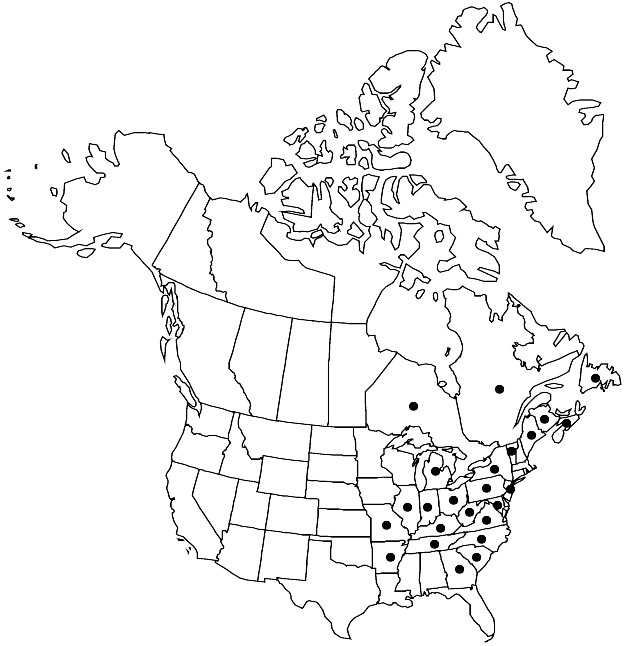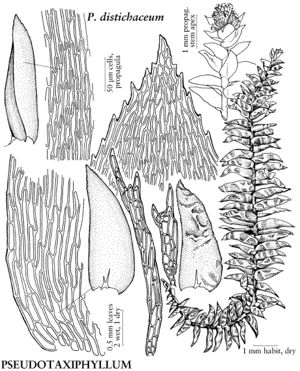Difference between revisions of "Pseudotaxiphyllum distichaceum"
J. Hattori Bot. Lab. 63: 449. 1987.
FNA>Volume Importer |
FNA>Volume Importer |
||
| Line 18: | Line 18: | ||
|name=Isopterygium distichaceum | |name=Isopterygium distichaceum | ||
|authority=(Mitten) A. Jaeger | |authority=(Mitten) A. Jaeger | ||
| − | }}{{Treatment/ID/Synonym | + | }} {{Treatment/ID/Synonym |
|name=I. subfalcatum | |name=I. subfalcatum | ||
|authority=(Austin) A. Jaeger | |authority=(Austin) A. Jaeger | ||
| − | }}{{Treatment/ID/Synonym | + | }} {{Treatment/ID/Synonym |
|name=Plagiothecium subfalcatum | |name=Plagiothecium subfalcatum | ||
|authority=Austin | |authority=Austin | ||
| − | }}{{Treatment/ID/Synonym | + | }} {{Treatment/ID/Synonym |
|name=Taxiphyllum howellianum | |name=Taxiphyllum howellianum | ||
|authority=H. A. Crum & L. E. Anderson | |authority=H. A. Crum & L. E. Anderson | ||
| Line 41: | Line 41: | ||
|elevation=low to high elevations (100-1700 m) | |elevation=low to high elevations (100-1700 m) | ||
|distribution=N.B.;Nfld. and Labr. (Nfld.);N.S.;Ont.;Que.;Ark.;Ga.;Ill.;Ind.;Ky.;Maine;Md.;Mich.;Mo.;N.J.;N.Y.;N.C.;Ohio;Pa.;S.C.;Tenn.;Vt.;Va.;W.Va.;Mexico (Jalisco;Veracruz;Zacatecas);West Indies (Dominican Republic);Central America (Costa Rica);South America (Brazil;Colombia;Ecuador;Venezuela);Asia. | |distribution=N.B.;Nfld. and Labr. (Nfld.);N.S.;Ont.;Que.;Ark.;Ga.;Ill.;Ind.;Ky.;Maine;Md.;Mich.;Mo.;N.J.;N.Y.;N.C.;Ohio;Pa.;S.C.;Tenn.;Vt.;Va.;W.Va.;Mexico (Jalisco;Veracruz;Zacatecas);West Indies (Dominican Republic);Central America (Costa Rica);South America (Brazil;Colombia;Ecuador;Venezuela);Asia. | ||
| − | |discussion=<p>Pseudotaxiphyllum distichaceum is easily confused with P. elegans, especially when propagula are absent. The asymmetric, often cultriform leaves of P. distichaceum will distinguish it from P. elegans, which has symmetric leaves that are never cultriform. When propagula are present, their location on the stems, as well as their morphology, are distinctly different in the two species. Pseudotaxiphyllum distichaceum has propagula that are elongate, twisted-vermiform with 1–5 acute teeth at the apices, and occur in the leaf axils at or near the stem apices, while P. elegans has propagula in the leaf axils always below the stem apices, and they resemble the parent plant, being much smaller, possessing small leaflike structures along their stems.</p> | + | |discussion=<p><i>Pseudotaxiphyllum distichaceum</i> is easily confused with <i>P. elegans</i>, especially when propagula are absent. The asymmetric, often cultriform leaves of <i>P. distichaceum</i> will distinguish it from <i>P. elegans</i>, which has symmetric leaves that are never cultriform. When propagula are present, their location on the stems, as well as their morphology, are distinctly different in the two species. <i>Pseudotaxiphyllum distichaceum</i> has propagula that are elongate, twisted-vermiform with 1–5 acute teeth at the apices, and occur in the leaf axils at or near the stem apices, while <i>P. elegans</i> has propagula in the leaf axils always below the stem apices, and they resemble the parent plant, being much smaller, possessing small leaflike structures along their stems.</p> |
|tables= | |tables= | ||
|references= | |references= | ||
| Line 64: | Line 64: | ||
|publication year=1987 | |publication year=1987 | ||
|special status=Selected by author to be illustrated | |special status=Selected by author to be illustrated | ||
| − | |source xml=https://jpend@bitbucket.org/aafc-mbb/fna-data-curation.git/src/ | + | |source xml=https://jpend@bitbucket.org/aafc-mbb/fna-data-curation.git/src/8f726806613d60c220dc4493de13607dd3150896/coarse_grained_fna_xml/V28/V28_875.xml |
|genus=Pseudotaxiphyllum | |genus=Pseudotaxiphyllum | ||
|species=Pseudotaxiphyllum distichaceum | |species=Pseudotaxiphyllum distichaceum | ||
Revision as of 17:08, 18 September 2019
Plants in thin, loose mats, light green to yellowish. Stems 2.5 cm, 1–3 mm wide, complanate-foliate. Leaves squarrose, not upturned-homomallous, distant, ovate- or oblong-lanceolate, asymmetric, cultriform, often strongly undulate, 0.3–1.8 × 0.2–0.6 mm; margins plane or narrowly recurved basally, serrulate to entire proximally, serrate to serrulate distally; apex acute to acuminate; costa double, strong; alar cells undifferentiated or quadrate to rectangular, 1–3 along margins; medial laminal cells 48–100 × 4–7 µm; distal cells sometimes prorulose at distal ends on abaxial surface. Specialized asexual reproduction often present as propagula clustered in leaf axils at or near stem apices, 0.1–0.5 mm, yellowish green, twisted-vermiform, with 1–5 acute, erect teeth at apex. Sexual condition autoicous. Sporophytes unknown.
Habitat: Soil, humus banks, sandstone bluffs, cliff ledges containing mica
Elevation: low to high elevations (100-1700 m)
Distribution

N.B., Nfld. and Labr. (Nfld.), N.S., Ont., Que., Ark., Ga., Ill., Ind., Ky., Maine, Md., Mich., Mo., N.J., N.Y., N.C., Ohio, Pa., S.C., Tenn., Vt., Va., W.Va., Mexico (Jalisco, Veracruz, Zacatecas), West Indies (Dominican Republic), Central America (Costa Rica), South America (Brazil, Colombia, Ecuador, Venezuela), Asia.
Discussion
Pseudotaxiphyllum distichaceum is easily confused with P. elegans, especially when propagula are absent. The asymmetric, often cultriform leaves of P. distichaceum will distinguish it from P. elegans, which has symmetric leaves that are never cultriform. When propagula are present, their location on the stems, as well as their morphology, are distinctly different in the two species. Pseudotaxiphyllum distichaceum has propagula that are elongate, twisted-vermiform with 1–5 acute teeth at the apices, and occur in the leaf axils at or near the stem apices, while P. elegans has propagula in the leaf axils always below the stem apices, and they resemble the parent plant, being much smaller, possessing small leaflike structures along their stems.
Selected References
None.
